Ripple Effects of a Drought
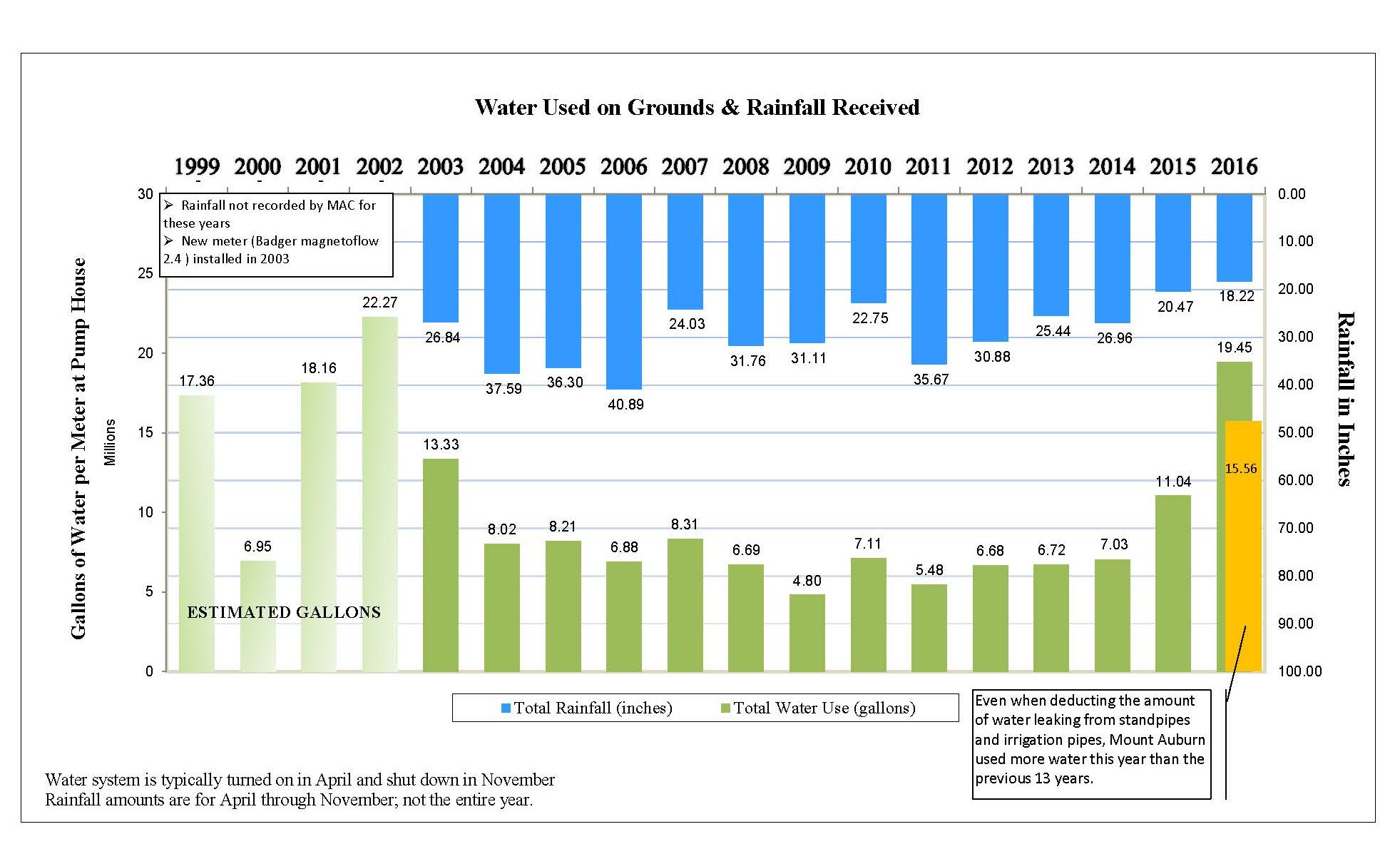 The effects of the unprecedented drought that Mount Auburn (and most of Massachusetts) experienced during the 2016 growing season will be felt for several years. The extremely dry conditions triggered an extended dormancy period for turf grass. Respite didn’t arrive until several fall rain events returned green grass to the landscape. The drought also created additional stress to trees and shrubs, as moisture was no longer available in the soil and microbial activity stalled. The danger of limb drop became more pronounced. The loss of a large limb from a mature oak revealed this over the summer. The full effect of the drought, however, won’t be fully realized until next spring as we begin to see if trees and shrubs will be slow to leaf out, or in fact, don’t leaf out at all. It was a challenge to meet the irrigation demands of the plant collections in 2016 through the limited and antiquated irrigation infrastructure. Nearly all 24 hours of every daily cycle were needed to shift resources and alleviate water pressure issues.
The effects of the unprecedented drought that Mount Auburn (and most of Massachusetts) experienced during the 2016 growing season will be felt for several years. The extremely dry conditions triggered an extended dormancy period for turf grass. Respite didn’t arrive until several fall rain events returned green grass to the landscape. The drought also created additional stress to trees and shrubs, as moisture was no longer available in the soil and microbial activity stalled. The danger of limb drop became more pronounced. The loss of a large limb from a mature oak revealed this over the summer. The full effect of the drought, however, won’t be fully realized until next spring as we begin to see if trees and shrubs will be slow to leaf out, or in fact, don’t leaf out at all. It was a challenge to meet the irrigation demands of the plant collections in 2016 through the limited and antiquated irrigation infrastructure. Nearly all 24 hours of every daily cycle were needed to shift resources and alleviate water pressure issues.
Mount Auburn’s superintendent of grounds already knows that many shrubs under perpetual care will need to be replaced, and special garden areas, designed and planted in 2016 at Beech and Central Avenues and Harvard Hill will require replacement plants as well. Throughout the Cemetery, more new gardens areas were created than in a typical year. Irrigation systems were set-up for those new gardens, but even with irrigation in place, some plants will not survive the stress of drought.. Even in perfect conditions, plant mortality is always anticipated, but these conditions were far from perfect.
2016 was a ‘perfect storm’ of issues. In the early spring, Mount Auburn experienced defoliation issues from winter moth, then came the persistent drought. Later in the summer, compromises to the integrity of the irrigation system impacted watering strategies.
Next year, arborists anticipate the beech trees (Fagus species) will show an advancement of decline. Also, they expect problems with dogwoods (Cornus florida and c. kousa). Even trees that have been growing for over a decade may show signs of drought stress like leaf die-back.
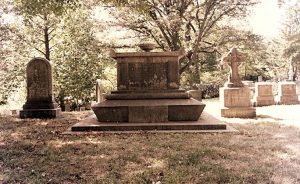 In addition to plants showing signs of stress, Mount Auburn may have a new stressor. Mount Auburn pumps water for irrigation of select garden areas and plants from a well that is 53 feet deep, located at the north basin of Auburn Lake. We may be back under the purview of the Department of Environmental Protection (DEP) regarding withdrawal of that well water, which is part of the aquifer that extends “north of Fresh Pond in Cambridge beneath the Charles River to North Brighton and beyond” (as reported in Mount Auburn Cemetery Water Conservation and Drought Management Plan, 2003, written in association with Emery & Garrett Groundwater, Inc. Waterville, ME). Mount Auburn is not yet certain if a new water withdrawal permit is required, but we do know the importance of continuing with our record keeping of water use.
In addition to plants showing signs of stress, Mount Auburn may have a new stressor. Mount Auburn pumps water for irrigation of select garden areas and plants from a well that is 53 feet deep, located at the north basin of Auburn Lake. We may be back under the purview of the Department of Environmental Protection (DEP) regarding withdrawal of that well water, which is part of the aquifer that extends “north of Fresh Pond in Cambridge beneath the Charles River to North Brighton and beyond” (as reported in Mount Auburn Cemetery Water Conservation and Drought Management Plan, 2003, written in association with Emery & Garrett Groundwater, Inc. Waterville, ME). Mount Auburn is not yet certain if a new water withdrawal permit is required, but we do know the importance of continuing with our record keeping of water use.
From 2003 to 2009, Mount Auburn reported annual water use to the DEP because the aquifer from which Mount Auburn draws its water is a Massachusetts resource, not a Mount Auburn one. In 2010, after several years of irrigation improvements including switching to low-flow sprinklers and reducing irrigation frequency, Mount Auburn no longer needed a permit to withdraw water from the aquifer and report to the DEP. In 2016 however, during the droughts of ‘extreme’ and ‘extraordinary’ categories, Mount Auburn pumped more water from the well than was typical to keep plants alive and water in the ponds at safe levels for the fish populations. As water warms up and pond levels are lowered by evaporation, the oxygen levels are also depleted which may result in fish kills. Mount Auburn has experienced fish kills in the past; therefore, water is added into the ponds to prevent that horrible situation from occurring.
We also experienced a problem this year with a pressure gauge on the well pump and consequently pumped more water than was actually required for irrigation. Due to the high pressure of water going through the old pipes, several leaks below ground occurred. In a typical year, those leaks are noticed because water bubbles up to the surface. In such droughty conditions, the bubbling up did not occur; therefore, it took longer to locate and fix the leaking pipes. Consequently, we’re estimating a higher leak rate of 30% rather than the typical 20% in most recent years. The water meter cannot determine what water is being leaked and what water is used for irrigation, so it appeared that all pumped water was used for irrigation. In fact, 4 to 6 million gallons went directly back into the earth recharging the aquifer. If the ‘leaked’ water is taken into account, then Mount Auburn used between 14 and 16 million gallons of water, which is still more than typical years. The full metered amount was 19.5 million gallons from the April to November season.
According to National Oceanic and Atmospheric Administration (NOAA) and The Weather Channel (TWC), the Northeast has equal chances of seeing above- or below-average precipitation and temperatures during the winter of 2017. So, it’s anyone’s guess what the weather will be like next year – warmer, perhaps, wetter? Let’s hope for gentle spring rains.
Working Together to Create a More Sustainable Mount Auburn
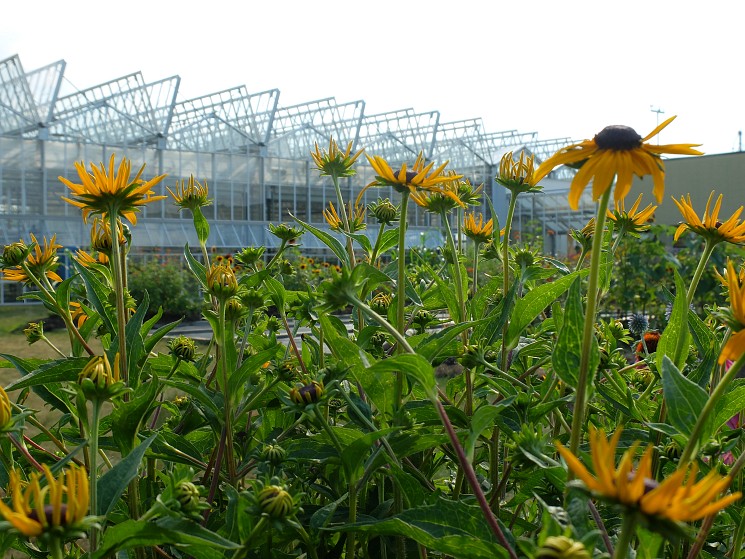
Mount Auburn Cemetery is a cherished landscape. It is cherished for its beauty and tranquility, and for its historical significance. But if you look closer, Mount Auburn is much more than this. It is a vibrant institution, leading the way on sustainable horticultural practice and reinventing what a sacred place can be. Mount Auburn has gained a reputation as an urban oasis. Ripe for many forms of scientific and social interpretation, from citizen science inquiry, to a backdrop for many artists to delve into the questions of life, death, and remembrance.
Mount Auburn is always changing. Visitors may notice the seasonal cycles on the grounds, but the changes that are unseen are equally important. We are striving to become as significant for sustainability, as we are for our plant collections and monuments. (more…)
Discovering the Effects of Drought on Soil: An afternoon with the Vacation Garden School
The Vacation Garden School is a summer camp for elementary school students that promotes stewardship of the earth and its resources. It is based at the Church of the Good Shepherd in Watertown, MA. The campers have visited Mount Auburn each of the past four summers and enjoyed activities relating to our diverse plant collections. This year the campers learned about soil prior to visiting Mount Auburn. On July 26, 2016 I planned to continue on this track by conducting an experiment with the campers demonstrating the water holding capacity of different soils. However, as eastern Massachusetts fell from moderate to severe drought, our time together evolved into a discussion on the effect of drought conditions on soil and the plant life it supports.
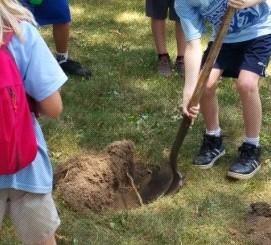
Vacation Garden School campers preparing for an experiment – filling a hole with water to determine how well the soil can hold water.
Originally, I planned to have the campers dig holes in several locations at Mount Auburn, each with a different soil composition. The campers would then fill each hole with water and let the water drain out. Once the water was gone, the campers would refill the holes with water and then measure the depth of the water with a yardstick. We would wait 15 minutes and re-measure the depth of the water. Once this was completed, the campers would multiply the difference from the first and second measurements by four to extrapolate the drainage rate of the soil per hour. The purpose of this experiment was to show the campers how a difference in soil composition affects the ability to store water and by extension, affects what plant material would be successful in that soil. For instance, a sandy soil drains quickly and therefore more drought resistant plants, such as sedums, are apt to be successful (with proper light conditions considered as well). Soils with higher amounts of organic matter have better structure and better water holding capacity. Most summer annuals, vegetables, and perennials are more successful in these conditions. Soils with higher organic matter also have greater diversity in the soil biology, resulting in much more activity in the rhizosphere, or root zone of the plant material. This zone is where the symbiotic relationship between soil organisms and plants sustains life.
The severe drought that we are experiencing is exhibiting obvious impacts on the landscape. Turf is brown and dormant. Leaves are wilting, and in some cases dropping. Mount Auburn is drawing from an aquifer (water below ground) at a higher than usual rate to sustain new plantings and some mature plants as well. Water has been pumped into Auburn and Halcyon lakes to support the aquatic wildlife in their battle for oxygen with algae blooms. The moisture content of the soil is non-existent and unable to meet the demands of all the competing root systems of the plant collection. Diversity of the soil biology has been depleted. The soil lacks the ability to prevent runoff and store rainwater.
In lieu of conducting the experiment as planned, the campers dug only one hole. We observed the lean, depleted look and structure of the soil. We looked at the all the plant material around us, noting the wilt of leaves and the brown turf areas and discussed the impact of drought on soil and plants, and the connection between the two. We also talked about the impacts of drought on our food supply and on wildlife, as well as the effects of erosion by wind and rain on the struggling soil.
In the end, we had a fine afternoon. The campers are concerned for the earth, and enthusiastic about science and experimentation. I hope that they will carry this curiosity with them throughout their lives.
Drought is about More than Brown Lawns
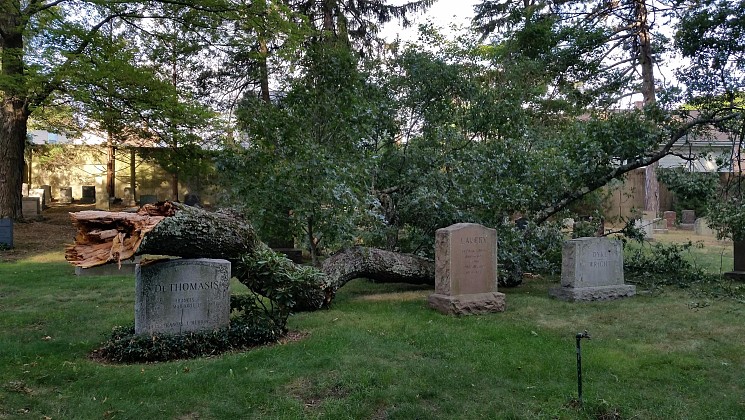
During a moderate or severe drought at Mount Auburn, we try to irrigate the new plantings that are zero (0) to five (5) years old, newly seeded lawn areas, and any trees that may have been stressed even before the drought began. We anticipate that some lawn areas will go brown – that is, dormant – until rain comes back to the region to brighten up the grass. But there’s another much more serious condition that is less well known.
Around 7:00AM on August 17, 2016, an otherwise ‘healthy’ limb dropped from an old oak tree for no apparent reason. This dropping of a long and relatively horizontal limb is characteristic of a phenomenon known as “summer branch drop” or “sudden limb failure.” There are different theories as to why this happens, but most experts believe it is partly due to a lack of adequate moisture in the soil. Our full-time arborist staff continually evaluates our tree collection and corrects structural deficiencies; however, since the science is not fully known for this problem, it is always smart to be aware of your surroundings and if you hear a popping or tearing noise from a tree move quickly away from it and notify a staff member.